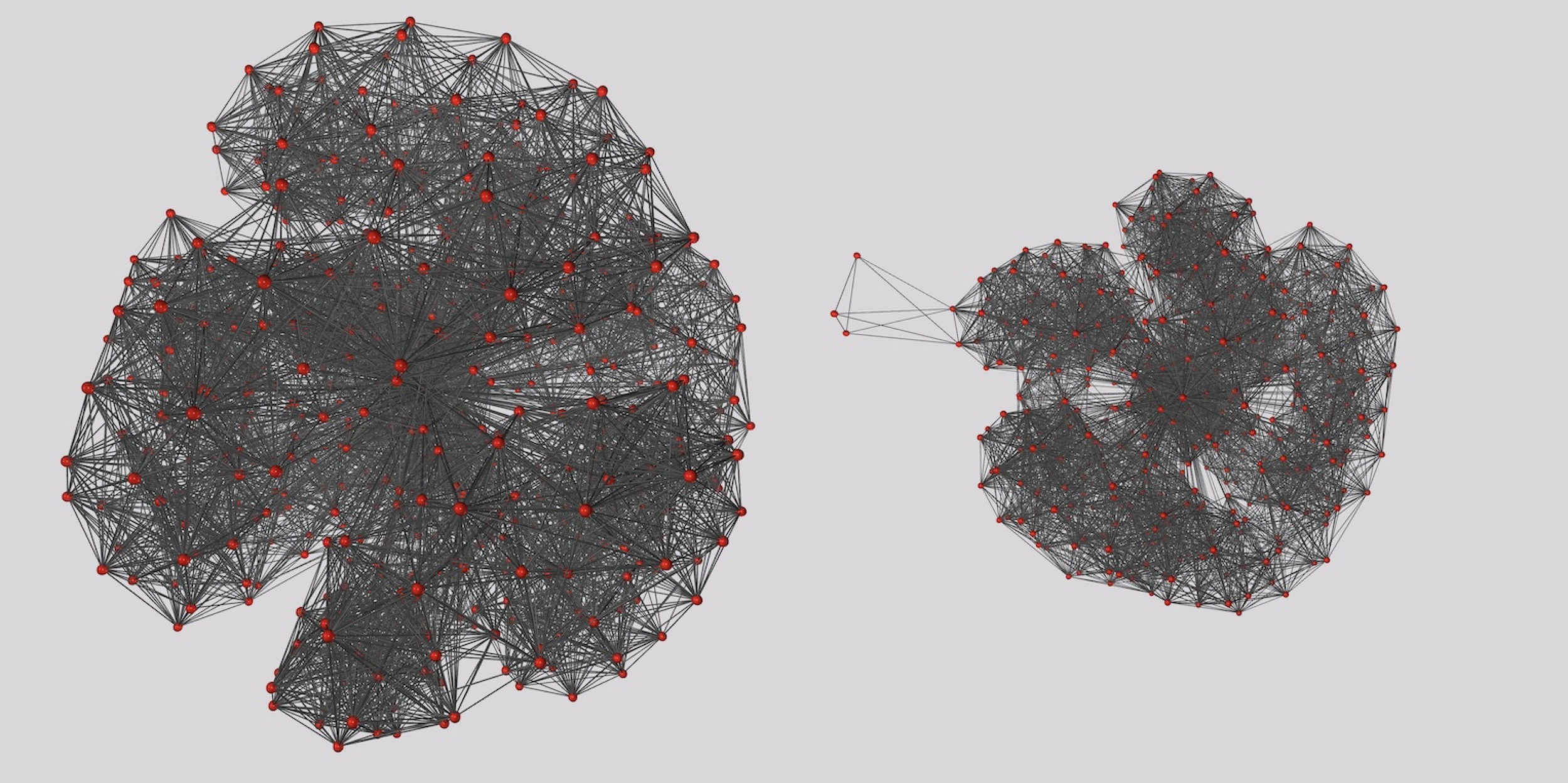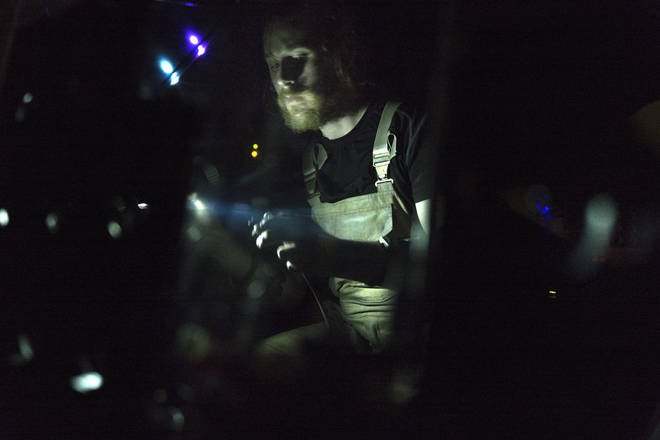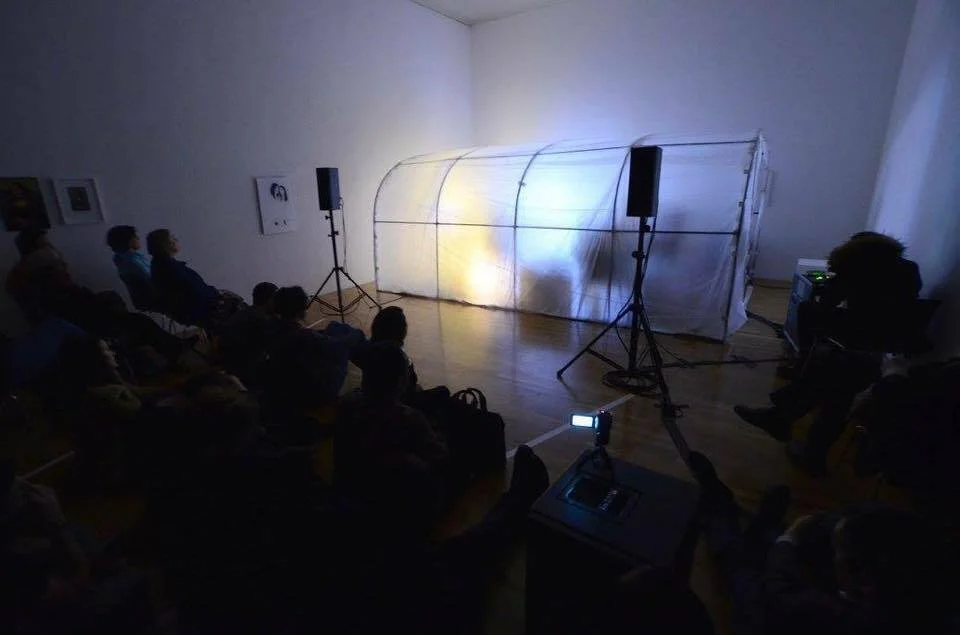
Interactive sculpture.
INFINITE
STOMACH
Mounted silicone actuators on canvas with 3d-printed self-pumping materials and homemade pigments. Currently in production at Disintegrator Test Lab in Minneapolis.
HYDRA
Interactive soft robot developed in collaboration with research partner Roberto Alonso Trillo. Hydra constantly subjects its environment to audio surveillance, using the Demiurge deep learning raw audio synthesis system to learn how to make music from the audience with which it interacts. Hydra is currently on exhibit at Seed Gallery in Shenzhen. Previously they were on exhibit at MAIN (Italy) and at Osage (Hong Kong).
Three versions of Hydra have been made, a 2m long poly/silicone actuator series, a 4m long poly/silicone actuator series with a large dome, and a 6m long silicone-only soft actuator series (made specially for Seed in 2023), which sits on silicone pools.
Some comments on Hydra:
At the center of what we do is this concept of reproductive matter — that there exist these charged materials or systems or protocols that freely and uninhibitedly reproduce with everything around them. What we call AI is one aspect of reproductive matter, a membrane that synthesizes and incorporates characteristics from its ambient environment. An algorithm that gives structure to a platform like Spotify, or an ad-serving tool, or a generative transformer — these examples are situations wherein some reproduction occurs across the complex plane of the human or the material and the digital, the quantized, the computational. (I could make a note here that capitalism is yet another aspect of reproductive matter).
When it comes to these situations, you could arbitrarily position them as having humans on one side and computation on the other — humans reproducing themselves through, let’s say, deep learning models, as in a kind of transhumanist fantasy, into a digitized expression of assembled consciousness. But of course the entanglement is far more severe, as computation itself is bound to some relatively incoherent and very human assertions about the nature of truth and reality, and it is of course also very much bound to the material world — from rare earth minerals extraction, assembly, UX design, social reconsumption, and reciprocal effects on human bodies in many ways. In reality, this reproductive situation has been occurring for hundreds if not thousands of years, and is something far more mutual or endosymbiotic. What is significant about the present moment is the visibility or identifiability of this mode of exchange or co-construction, and of course the chorus of terror that has accompanied AI around precisely this question — what does it mean to consent to a kind of parasexual encounter with silicon? What does it mean to give collective social birth to computational inheritors that theoretically could exceed their semi-parents in scope and thought and capability? These things are rarely discussed in terms of reproductive ethics, but rather in the more mundane discourses of intellectual property, consumer data protection, and geopolitics.
Hydra takes its metaphorical basis in the small freshwater animal of the same name, which has a really interesting reproductive system — it can reproduce asexually, via budding, it can regenerate itself from cleaved bits, and it can also reproduce sexually. It has a series of tentacles that function as arms, but also as paddles, and indirectly as reproductive organs as well. Our Hydra sculpture sits aperch an environment of silicone pools, blowing air into silicone tentacles that slowly move themselves around those environments. Those tentacles are intended to elicit worms tilling soil, rice cakes representing nourishment, and phalluses spilling reproductive material. Their function is to draw in the external world and elicit audio feedback from its audience, which it then reproduces with freely and without pause.
A highlight of the show is an illuminated sound installation sculpture called Hydra — a set of transparent jars oozing incessant streams of poly nodes through its multiple spouts. The look and feel is that of a living, breathing, vibrating, gasping organism, procreating endlessly, as it lets out ear-splitting shrieks under induced labor.
— China Daily
Winner: Award of Distinction
— MAIN/Manifeste 2023







POLYP
Polyp was designed and prototyped with research partner Roberto Alonso Trillo. A Polyp is silicone soft robot that is used to train the Demiurge raw audio synthesis engine. They sample their environments, upload them to the Cloud, and can retrieve and play back audio trained specifically against their sample set. Polyps have been on display at Seed Gallery in Shenzhen (2023), at the Shenzhen Art Museum (2024), and are currently on display at the EPFL Pavillions in Lausanne, CH (2024-25).
Some notes on Polyp:
Polyps take their name from the class of animal that the Hydra is, but they also reflect eggs within the human female reproductive system and also cancers, specifically uterine cancers but other cancers as well. Cancer is of course the ultimate biological reproductive material, a kind of simultaneous reproductive death-drive and absolute, categorical fertility and evolutionary potentiality. These Polyps sit on a bed of silicone plastered yak hair, intended to represent both nests and pubic hair.
Over the course of the exhibition, we expect Polyps to map and model the audio environment of the gallery, while at the same time imparting their own distinctive signatures within that space, raising, hopefully, the hackles of an audience member who is confronted, maybe for the first time very clearly, with the idea that they are constantly and irrevocably, with varying levels and dimensions of consent, not only with their environment but with the algorithmic reconsumption of their environment, ceaslessly and without pause. There are two ways to feel about it — horror, that one’s every thought is sampled and mobilized by partially incomprehensible and invisible forces, and — alternatively — a kind of strange solidarity with a humanity that is coparenting the future.



INTERDICTOR
Interdictor is an opera about technology as thanatropic escape vehicle, and a lament for the impotence of art under the situation of civilizational collapse. Developed for the Munich Biennale 2018, funded in partnership with Spielmotor München (a relationship between BMW and the city of Munich), and hosted by the Villa Stuck. Performed by Christian Smith. Constructed with Markus Oppenländer and Axel Block in partnership with littleBit Köln. Inductive sensors developed by Fraunhofer IZM Berlin. Footage from Armin Smailovic.
Interdictor uses neural networks to grab quaternion data from EMG input (muscles) and inductive sensor data (positioning), allowing the user of the spacesuit to send high-resolution commands to the spaceship itself. The performer both plays with and improvises against the spaceship in its piece.
Software and hardware interface by Marek. Concept and design by Marek. Composition in collaboration with Christian Smith.
Interdictor was featured by Adafruit in 2018.
More information about the sculpture itself in the section below.





INTERDICTOR
Aluminum structure, 640 computer fans bitbanged into FM synthesizers, 24-microcontroller network, 6 channel transducers, LEDs. Constructed with Markus Oppenländer and Axel Block in partnership with littleBit Köln. All architectural, electrical, and software design by Marek.
Live construction at the Kolumba Museum (Cologne) in July/August 2017, premiere exhibition at Kolumba anniversary event. Project developed in partnership with the Münchener Biennale.
Re-exhibited in 2019-2020 and acquired by the museum.
VIDEO DOCUMENTATION
AUDIO DOCUMENTATION
MORE INFO
DROCH
Homemade electromechanical instruments. Commissioned and premiered by Chartreuse (Carrie Frey, Myra Hinrichs, Helen Newby). Performed with video animation by Erika McLepke and Dan Tramte, video by Caufield Schnug, and live electronics by Jenn Grossman. Developed at the Avaloch Farm Music Institute, supported by the Somerville Arts Council.
AUDIO DOCUMENTATION
VIDEO DOCUMENTATION
MAW
Amplified quartet with homemade and electronic instruments, video and light. Commissioned by the Bludenzer Tage zeitgemäßer Musik, supported by grants from the Ernst von Siemens Music Foundation and the Harry and Alice Eiler Foundation. 2015 version developed with Brian Archinal, Christian Smith, Felix Del Tredici, and Eva Zöllner at Verein Flatterschaft (Basel). 2017 version developed with additional work by Murat Çolak, Erika McLepke, and Dan Tramte and exhibited with the support of the Somerville Arts Council.


